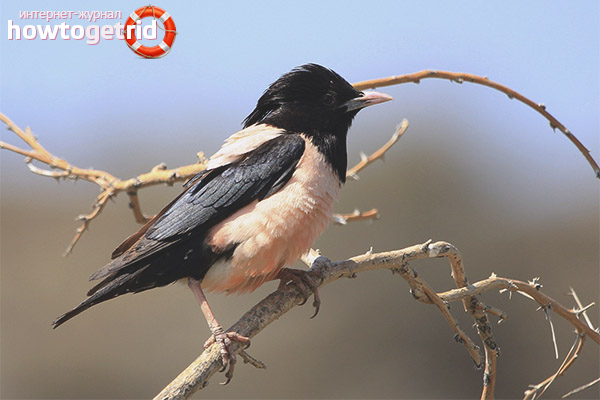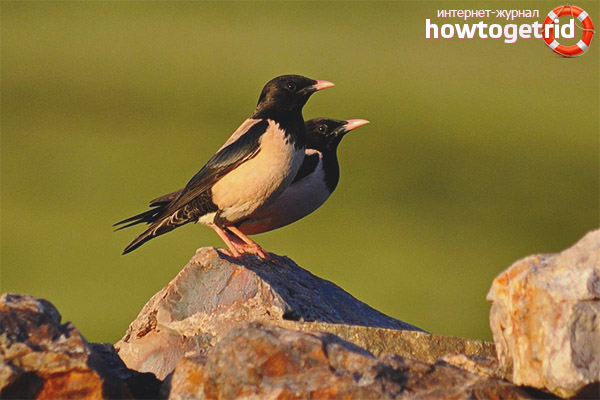The content of the article
Under the pink starling is understood quite interesting in its external characteristics of the bird. Representatives of the family prefer to build nests in rocky terrain, as well as in the crevices of stone buildings. They are found in mountainous areas, near ravines and other places of this type. Separate couples who want privacy and a quiet existence, occupy empty hollows in the trees.
Description
- These individuals are somewhat similar to their ordinary counterparts. The difference lies only in the length of the beak, it is shorter, and overall characteristics. Pink representatives are slightly smaller. The grown starlings differ from the self-like with a contrasting color of plumage and the presence of a crest. As for the sizes, birds grow up to 24 cm in the body. Maximum with a mass of 80 g. If we consider the wingspan, it is about 40 cm.
- In the summer and spring, the birds are distinguished by the contrasting color of the feathers. They can be whitish with pink spots, pure pinkish, as well as black with a purple or blue tint and a metallic sheen. The last feature is characteristic of the brisket, head, wings, legs, thighs, hips, tail.
- But the most important characteristic is a crest falling down. The irises are brownish, the legs are pink. The beak is pigmented in pink or yellow with a dark base. It is short and not so pointed than that of a fellow of ordinary type.
- Studying the differences in gender, it is important to highlight that the representatives of the male and female gender have practically none. Unless the females are not so saturated in their shade, they have a short tuft and a faint glow of plumage.
- Young growth, which has not yet crossed the one-year mark, cannot boast of bright and contrasting feathers. The younger generation is dull, unlike old birds. Black-brown head, wings, tail, neck. The back is pigmented in a dirty brown tone, and violet-red inclusions are observed behind the neck. There are practically no shades of pink.
- There are no mottled stripes in the area of the sternum and peritoneum, but there is an ocher color with gray marks. The tail is darkish, as are the wings. Edges of ocher shade are observed in these areas. These individuals differ from ordinary young starlings by their light color, not sharp beak, and the contrast of the color palette on the wings and the body itself.
- When a bird is in flight, it is difficult not to notice or confuse it with traditional members of the family. Our pink counterparts are quite contrasting, especially the area of the tail and wings stands out.
Habitat
- Many birds from this breed group were seen off the coast of Turkey, as well as in Pakistan and Mongolia. Forgiven the population throughout Eurasia. Wintering off to Sri Lanka (India).
- On the expanses of our homeland are quite rare due to the fact that climatic conditions are not suitable for them. They are also common in the Caucasus, Volga region and Crimea.
- Individuals belong to nomads, because they are constantly in search of food. They feed on locusts. They live in the steppe zones, in forests are rare and unpopular.
Lifestyle
- Birds prefer to keep in packs. Birds love to live in open spaces and pastures. The main condition remains that such territories must be located near the water bodies. For the same reason, individuals often fly to a watering place.
- The diet of pink starlings is based on invertebrates. Birds prey on prey, mainly on land. They move in short dashes or in steps.Only in rare cases can starlings catch insects on the fly.
- Individuals love filly and locusts, and birds destroy such insects in large numbers. It is often possible to observe the picture that swarms of birds accompany herds of cattle. In summer, birds allow themselves to feast on berries and seeds of plants. Sometimes birds harm vineyards.
- Individuals try to nest in dense and rather large colonies. You can often see that in such groups there are up to several hundred pairs of birds. Birds settle in quarries, abandoned buildings, on cliffs off the coast and mounds. Only in rare cases do they live in hollows.
- In addition, large bird settlements can be seen in those places where outbreaks of a huge number of locusts and similar insects are observed. The nest is a loose and shapeless building. At a time, the female lays no more than 6 eggs with a bluish tint. Parents hatch offspring together about a crescent.
- After the young animals were born, adult individuals continue to feed them up to 20 days. After this, the chicks become on the wing and adjoin large flocks. Further, large groups of birds begin to roam in search of food. This continues until the departure for the winter.
Breeding
- If we take Central Asia into account, the nesting season in such territory falls in mid-spring. In southern Europe, the mating season in birds begins almost at the same time. Starlings reach puberty as early as 1 year.
- Couples build their nests in wall cracks, rock crevices, under tree roofs and sometimes in hollows. In such a period, up to several thousand individuals can be counted in nesting colonies. Roots, twigs and leaves are taken as the basis for the building material of the bird.
- The bottom of the dwelling is lined with moss, feathers and wool. In addition, birds often put branches of bitter wormwood and ordinary ferule in the nest to scare away the parasites. Parents can return to the nest for several years in a row.
You can hardly find these pink feathered representatives in the forest-steppe, as well as in the territory of our country. Birds go for the winter to India, because the local climatic conditions suit them. They differ from ordinary representatives of the family in smaller overall characteristics and a blunt beak. They feed on locusts; they like to nest in a rocky zone.
Video: pink starling (Sturnus roseus)











Submit